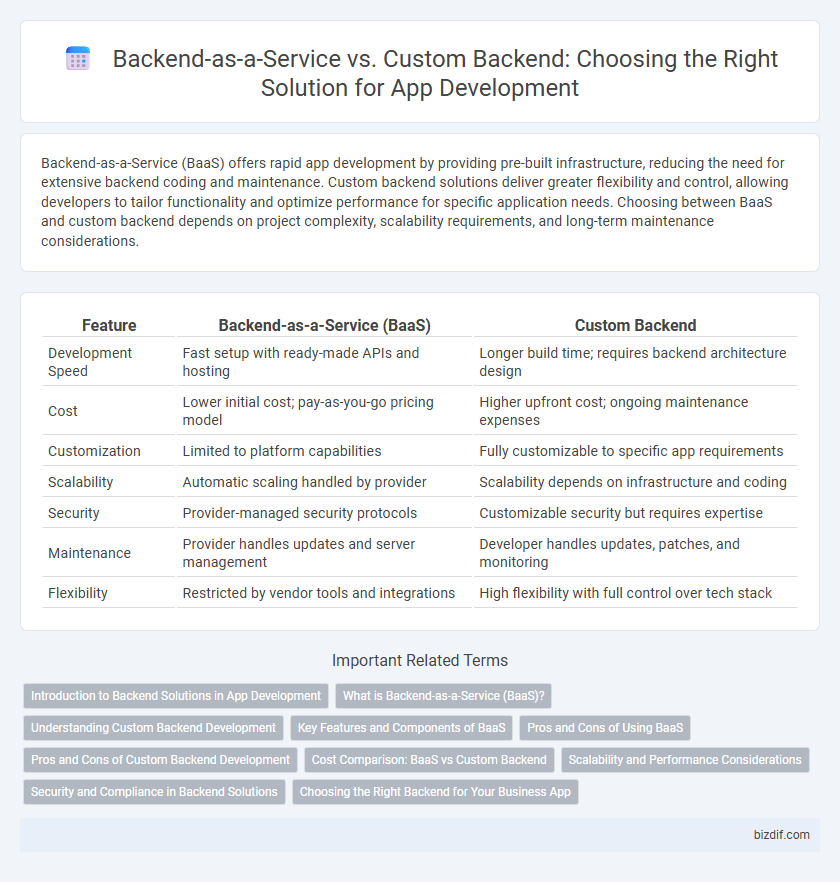Backend-as-a-Service (BaaS) offers rapid app development by providing pre-built infrastructure, reducing the need for extensive backend coding and maintenance. Custom backend solutions deliver greater flexibility and control, allowing developers to tailor functionality and optimize performance for specific application needs. Choosing between BaaS and custom backend depends on project complexity, scalability requirements, and long-term maintenance considerations.
Table of Comparison
| Feature | Backend-as-a-Service (BaaS) | Custom Backend |
|---|---|---|
| Development Speed | Fast setup with ready-made APIs and hosting | Longer build time; requires backend architecture design |
| Cost | Lower initial cost; pay-as-you-go pricing model | Higher upfront cost; ongoing maintenance expenses |
| Customization | Limited to platform capabilities | Fully customizable to specific app requirements |
| Scalability | Automatic scaling handled by provider | Scalability depends on infrastructure and coding |
| Security | Provider-managed security protocols | Customizable security but requires expertise |
| Maintenance | Provider handles updates and server management | Developer handles updates, patches, and monitoring |
| Flexibility | Restricted by vendor tools and integrations | High flexibility with full control over tech stack |
Introduction to Backend Solutions in App Development
Backend-as-a-Service (BaaS) provides pre-built cloud infrastructure, enabling developers to quickly integrate databases, user authentication, and server-side logic without managing servers. Custom backend development offers tailored solutions designed to meet specific application requirements, ensuring full control over performance, security, and scalability. Choosing between BaaS and custom backend depends on project complexity, development resources, and long-term maintenance goals.
What is Backend-as-a-Service (BaaS)?
Backend-as-a-Service (BaaS) is a cloud-based solution that provides pre-built backend infrastructure, including databases, authentication, and server-side logic, enabling developers to focus on frontend development without managing server maintenance. BaaS platforms like Firebase, AWS Amplify, and Parse offer scalable APIs and real-time data synchronization, significantly reducing development time and operational overhead. This service is ideal for startups and projects requiring rapid development with minimal backend expertise.
Understanding Custom Backend Development
Custom backend development offers tailored server-side solutions by building APIs, databases, and business logic from scratch, ensuring full control over performance and security. Unlike Backend-as-a-Service (BaaS), it allows seamless integration with unique application requirements and proprietary data models. This approach is essential for apps needing complex workflows, advanced scalability, or specific compliance regulations.
Key Features and Components of BaaS
Backend-as-a-Service (BaaS) provides developers with ready-made key features such as user authentication, real-time databases, cloud storage, and serverless functions, eliminating the need to build and manage backend infrastructure from scratch. Core components include API management, push notifications, and scalable cloud hosting, enabling rapid app deployment with reduced development time and operational overhead. BaaS platforms focus on integration simplicity, security protocols, and automatic scaling, making them ideal for startups and projects requiring fast iterations.
Pros and Cons of Using BaaS
Backend-as-a-Service (BaaS) offers rapid development by providing pre-built backend infrastructure, reducing time and cost for app development projects. It simplifies scalability and maintenance with managed servers, but limits customization and can lead to vendor lock-in or security concerns. Choosing BaaS suits startups needing quick deployment, while enterprises with complex requirements often prefer custom backend solutions for greater control.
Pros and Cons of Custom Backend Development
Custom backend development offers full control over database architecture, API design, and security protocols, enabling tailored solutions that align precisely with business requirements. However, it demands significant investment in time, skilled developers, and ongoing maintenance, which can increase project costs and complexity compared to Backend-as-a-Service (BaaS) platforms. The custom approach enhances scalability and flexibility but requires rigorous planning and resource allocation to ensure long-term performance and adaptability.
Cost Comparison: BaaS vs Custom Backend
Backend-as-a-Service (BaaS) typically offers lower upfront costs due to its ready-made infrastructure and prepaid pricing models, which reduce initial development time and expenses. Custom backend development incurs higher initial costs from designing, coding, testing, and maintaining a tailored solution, but may optimize long-term expenses by avoiding recurring BaaS subscription fees. Evaluating total cost of ownership (TCO) requires comparing scalability needs, maintenance overhead, and feature complexity against the fixed pricing and managed services of BaaS platforms like Firebase or AWS Amplify.
Scalability and Performance Considerations
Backend-as-a-Service (BaaS) platforms offer scalable infrastructure with auto-scaling features that efficiently handle fluctuating user loads, reducing the need for manual server management. Custom backends provide tailored performance optimizations and fine-grained control over resource allocation, enabling businesses to fine-tune scalability for specific application requirements. Selecting between BaaS and custom backend development requires assessing expected traffic patterns, latency demands, and long-term scalability goals to ensure optimal app performance.
Security and Compliance in Backend Solutions
Backend-as-a-Service (BaaS) provides built-in security features and compliance certifications such as GDPR and HIPAA, reducing the burden on developers to manage data protection protocols. Custom backend solutions offer tailored security measures, enabling organizations to implement specific encryption standards and access controls aligned with unique regulatory requirements. Selecting the appropriate backend depends on the trade-off between rapid deployment with standardized compliance and highly customizable security architecture.
Choosing the Right Backend for Your Business App
Backend-as-a-Service (BaaS) offers rapid deployment, scalable infrastructure, and built-in security features, ideal for startups and small businesses seeking cost-efficiency and faster time-to-market. Custom backend development provides tailored functionality, full control over architecture, and flexibility for unique business logic, making it suitable for companies with complex requirements and long-term scalability needs. Evaluating project scope, budget, and growth projections ensures the right backend choice aligns with business goals and user experience demands.
Backend-as-a-Service vs Custom Backend Infographic

 bizdif.com
bizdif.com